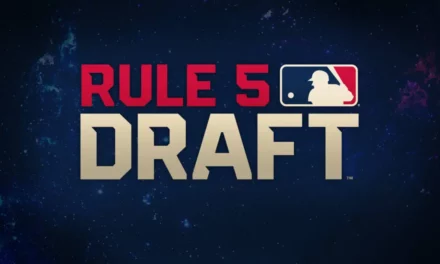On Thursday night, Seth Corry took the mound, and he had a night of highs and lows. He got a season-high in strikeouts, with nine, and also a season-low in walks (2). But what really hurt was that he gave up highs in hits allowed (5) and runs (6). How did this happen?
Well, watching this game, it was clear that the approach on him that victimized him was a plan by the Vancouver Canadians. They had a book on him.
Scouting reports are hard to come by in the minors compared to in the bigs, but they do exist. Especially when it comes to big names like Seth Corry, who really announced himself with a monster 2019 season. In this game, Vancouver was clearly working on one. It showed through in both his successful innings and the ones that went wrong. So what’s the book?
Bases Empty: Take pitches and let Corry put you on.
Runners On: Wait for fastballs and swing away until 2 strikes.
That’s it. That’s all it takes for a book.
Seth Corry had two good innings, let’s look at those first.
(You may look at the official MiLB website’s box scores and recap, but don’t trust the pitch locations shown there, as they aren’t very accurate.)
First Inning:
Corry threw nearly all fastballs, and he was working effectively high in the zone. Both batters were taking until there were at least two strikes. The first batter (RHH) took two fastballs way out of the zone, but then took three belt-high fastballs, nearly all on the inside part of the plate. The second batter (LHH) watched Corry worked inside and then out low in the zone, then fouling a couple of fastballs off before striking out swinging on a high fastball. The second batter got Corry’s only curve, which was way outside and low, missing the catcher completely.
The only outlier was Cameron Eden (RHH), one of Vancouver’s top hitters. After Corry missed with two fastballs (first high, then inside), he delivered a fat pitch down the pipe, and Eden swung at it, the first strike he saw. It nearly worked, as he lined a drive that required a catch at the top of the wall by center fielder Franklin Labour to catch, and the inning was over.
Third Inning:
Fastforwarding, let’s look at Corry’s best inning. The first batter took two balls, but the batter started swinging at pitches in the top of the zone, again, breaking from the book. He fouled one off, took the second strike, and then swung and missed.
The second batter took one strike, then began fouling pitches off. He, too, would strike out swinging on a check swing, this time the victim of Corry’s big hook, the only pitch that was down in the zone other than his high fastballs.
The third batter took two balls, fouled off a fastball, and then took two more strikes, including a high curve that caught the zone that the batter watched go by. Again, breaking the pattern, swinging and missing for the first strike.
That was Corry striking out the side in an excellent inning.
Note all the details about pitches up in the zone, because when Corry got into trouble, it wasn’t up in the zone. Let’s look at the innings where Corry had trouble.
Second Inning:
Here’s where some of the trouble started, and the pattern was established.
Corry started the first batter (RHH) low and inside with a fastball for a strike, but then got wild. He missed low and outside, and then another fastball low and outside was fouled off. The batter laid off a curve that missed low and outside, and then fouled off a curve that was over the plate. Corry got the strikeout swinging on a fastball high in the zone.
The next batter (RHH) was where Corry got really wild. He walked him on four pitches, though none of the pitches were close. All four pithes missed with some combination of low and inside, and the first baserunner was on. Here things change.
Next up was a slugging LHH, and on the first pitch he jumped on a fastball over the plate for a double to the right field corner. That was followed by another RHH, and he hit a single to left on a fastball on the inside part of the plate, again on the first pitch.
First pitch fastballs, both were jumped on, both for sharp hits.
The next batter, with a runner on first, took a curve on the first pitch, and watched it go low. He got a fastball on the next pitch, and swung at it, fouling it straight back. Corry threw a changeup high, and again the batter took it. Corry got a changeup in over the knees, and the batter took it for the strike. With two strikes, two fastballs got fouled off while Corry missed with a curve that was not close. Corry did get the strikeout on a high fastball swinging, and the runner was caught stealing to end the inning.
Fourth Inning:
The fourth was a bit of a mixed inning, but notably, Corry got outs when Vancouver hitters broke from the pattern.
The first batter (RHH) took a curve wide for the first pitch, and easily took a fastball that was bounced in. The next fastball was up high, and then the fourth was yanked low and inside again, and the 4-pitch walk set things off again.
The second batter (LHH) jumped on the first pitch fastball, fouling it off. The next pitch was a fastball that went over the catcher and ump to the backstop. On 1-1, the batter took a curve that missed outside. The fourth pitch was a fastball that the batter swung at, flying out to left.
The third batter (RHH) took a high changeup for a ball to start the at-bat. He did break with the pattern, taking a fastball that he backed off from but it was a called strike. He fouled off a 1-1 changeup, again a break from the pattern. He would foul off a curve and take a fastball low and in before topping a curve that Corry fielded with a leap to get the second out.
The fourth batter (LHH) took a curveball low and outside. The next pitch was a fastball, and guess what he did? He jumped on a hit a fly ball that fell in just in front of the center fielder. Corry would hit the next batter (RHH) on the first pitch on a fastball that hit him in the ankle (another low and inside miss to a RHH, in a more drastic way).
For the fifth batter (RHH), Corry threw a changeup high that looked like a called pitchout to try and pick off the runner at first. The batter took a fastball on the outer half of the plate to make the count 1-1, and then fouled off the next pitch, another fastball. He would swing and miss at a high changeup to get out of the inning.
Fifth Inning:
Here was Corry’s bad ending.
The first batter (RHH) took a fastball on the outside half high for a strike. He then took a fastball down the pipe to fall behind 0-2. Corry then began to miss, with a fastball low and in, a curve low and in, and a fastball outside. With the count full, he line a fastball that was low over the plate for a double.
With a runner back on, Corry led off the next batter (RHH) with a fastball over the middle of the plate that was foul-tipped into the catcher’s mitt. The batter then fouled off a fastball that was middle-in. He missed with a fastball way outside to make the count 1-2, and then got a groundout to second on a curve.
Next up was a LHH, and he took a curveball high for a ball. He took a curveball then in the heart of the zone. He finally got a fastball 1-1, and fouled it off. With two strikes, he fouled off a fastball high and a curve that was low. He struck out on a check-swing foul tip on a fastball high.
Corry struggled to the next hitter, a RHH, throwing a fastball wild for the first pitch (the batter made the easy take), and then took a changeup that was way inside, and then threw a curve that got the batter on the toe to put him on.
With runners on the corners to a LHH, Corry threw a fastball high on what looked like called pitchout with the league-leading basestealer on first (he stole it anyway, as the catcher couldn’t hold on). The next pitch was a fastball high in the zone over the plate, and it was lined for a home run.
TLDR
Okay, that was a lot of recapping, but let’s break this down.
When the bases were empty, Vancouver was almost always taking his first pitch, and not swinging until there were strikes. Notably, the only two walks Corry issues were 4-pitch walks, no strikes thrown.
When there were runners, batters were almost always taking the offspeed pitches, but swinging at fastballs (unless the fastballs were obviously out of the zone, including two apparent pitchouts).
Every place the Canadians broke the pattern led to outs, though one by just barely. The main place where hitters broke the pattern was the fourth inning, when they only got Corry for one run after a leadoff walk. Both the batters who broke the pattern made outs, and the damage was limited thanks to those outs. In the third inning, one of the batters jumped on the first fastball he saw, fell behind, and would strike out.
The only other spot was the first inning, when their top hitter jumped on a fat pitch, but that time he came within inches of home run. It still ended in an out, though it was a good swing and the right decision.
Not every time batters follow the plan will they get a hit. Not every time they break from it they will fail. It’s all about playing percentages. On this night, it worked for Vancouver.
You might think that this is a lot of words to say the obvious. “Duh, if a pitcher’s being wild, take until you get a strike.” And, you aren’t wrong. The obvious fix here is for Corry to fix his command enough to get his offspeed pitches into the zone, or to pump fastballs in the zone more consistently to get those early strikes. And of course, that fix is easier said than done. But there’s more to think about here.
First: Corry’s fastball is easily his key pitch. Vancover made no solid contact on any offspeed pitch all night, though they had a very small sample size of offspeed pitches in the zone to work with. But it’s notable that Corry’s fastball seemed far more vulnerable in the stretch as opposed to in the windup. Corry gave up one solid hit out of the windup, but otherwise, batters were either fouling off his fastballs from the windup or completely missing them. Out of the stretch, however, his fastballs were generally getting hit harder, both for fouls and for hits.
This might be explained by hitters sitting on a pitch type. But part of me wonders if there’s different movement on Corry’s fastball out of the windup than the stretch. Corry uses a toe-tap windup movement, similar to Clayton Kershaw, which he obviously can’t use in the stretch. I have no data to back this up, so I’m only theorizing, but I’d wonder if advanced equipment would show different breaks in the two fastballs.
Secondly: Batters were doing an excellent job recognizing Corry’s pitches. That’s concerning that they could not only sit on a pitch, but most of the time saw it well enough to do it consistently. Corry’s changeup only showed up three innings in, and it was not at all effective in any way. Somehow increasing the deception factor here is a key for Corry’s development.
Third (and also, just an obvious point): Corry needs to figure out his fastball. He was consistently yanking it down and to the RHH batter’s box. Both of his walks in this game had those types of misses as a big factor. Getting ahead early in counts breaks this sort of book, so even doing that with a fastball will help.
Obviously, this is just one game, and one team’s book on Corry. Hopefully he can make adjustments to his control, which will make this sort of a plan less useful and effective. Opponents of course will make more adjustments, to which Corry and the Giants will do the same. But ultimately, if the Giants can get Corry to the point where he can make it so hitters don’t come in with a plan, and have to adjust to each pitch one by one in each at-bat, Corry’s devastating curve will be able to dominate and Corry will become the star that he has the ability to be.







Recent Comments